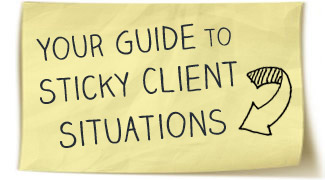For modern-day entrepreneurs and small business owners, not being able to write good online content is crippling to any business strategy. If you don’t have a strong online presence, you might as well not exist. Yet to get and maintain a strong online presence, you need to provide high-quality content. Sure, you can outsource to other writers. Or can you?
Because most entrepreneurs, especially us moms, are operating on shoestring budgets as it is, we need to teach ourselves how to write for the web. Whether it’s writing your own website copy, creating content for social media or maintaining a blog, being able to create quality web content on your own will not only save you money, it’ll help you position yourself as an authority in your industry, which leads to traffic, sales and profit.
So without further ado, follow these steps to become a whiz at writing for the web:
Step 1: Define Your Goal
The first thing you need to do when you sit down to write any piece of content is define the purpose for its existence. What will it accomplish? A goal is important because it serves as a framework to help guide your writing.
Any piece of content is meant to accomplish one or more of the following actions:
- Educate
- Entertain
- Inform
- Persuade
- Motivate
So when determining your goal, use one of these goals in mind and it can help you frame your outline or the overall message you are trying to deliver.
It’s also important, when writing for the web, to be very specific with your goal. With so much information available online, visitors only want to read content that is very specific to any given query.
When writing a goal for a piece of content, use the following model:
My goal is to (educate, entertain, inform, persuade or motive) my (target audience) to (insert specific goal).
Step 2: Identify Your Target Audience
Just like it’s important to define your goal for a piece of content, it’s critical to identify your audience as well. By doing so, you’re more likely to align your content with the needs of that particular audience. Be very specific with your target audience just like you were specific with your goals.
Step 3: Do Your Research
After you’ve identified your goals and audience, it’s time to gather your research. Unless you’re an expert on the topic, you’ll probably need to do research to gather supporting points or add more flavor to your content.
Do the majority of your research prior to doing any writing. It helps to have all of your information nailed down before writing so that you can envision how you want the content to come out. Also, by doing this, you won’t have to take breaks when you’re in the groove of writing to find more support for your content.
I like to make a document in Word when I’m researching. I copy and paste all relevant information that I want to remember or use into that Word document next to its respective hyperlink and/or citation. Then as I’m writing, I can easily put the research document next to my own content to remind myself of interesting points I want to include.
Step 4: Know Your Keywords
Keywords are a detrimental component to your online content if you want to get the right information in front of the right audience. So with your goals, audience and supporting research in mind, do some keyword research.
Ask yourself what phrases your audience will be using when searching for this particular piece of content and then use Google’s keyword tool to discover the best choices for keywords and phrases.
Having your keywords nailed won prior to writing makes it easy to integrate them into your content. Otherwise, you’ll have to edit your final content later to fit your keywords and that’s a huge, time-consuming pain.
Step 5: Outline
An outline to a writer is like a blueprint for an architect. Without it, you’ll have no framework with which to work from. Spend a half an hour organizing your thoughts before writing. Simply jot down a quick outline with respective information: introduction, main point, supporting points and conclusion/summary.
Need a great resource? Try these great ezine templates for expert authors to get you started.
Step 6: Free Write
After your information is organized, it’s time to write. Using your outline, spend an hour free writing. Don’t worry about grammar, spelling or transitions; just simply write as you would if you were having a conversation with someone.
Step 7: Take a Break
The worst thing you can do as a writer is not take any breaks while writing a piece of content. The best time to take a break is after you spend some time free writing. Doing so enables you to come back to your content with a rejuvenated mind which, in turn, will make you more efficient for the next step. Spend 15 minutes and go outside to get fresh air, get some water or play with the dog. Whatever you do, aim to clear your mind.
Step 8: Rewrite
The next step is rewriting. This is where you take all of the “rough” content from step 6 and polish it into a gem. During this stage you will also insert your keywords, make sure your sentences flow, add additional supporting points, delete negligible information, add hyperlinks to cited content and so on.
Step 9: Proofread
After you feel like your content is in a good spot, take another 15 minute break before diving into proofreading. Then when you’re ready, check grammar, spelling, punctuation, etc. to make sure your content is error-free. A minor spelling error can make readers doubt your expertise or authority so make sure you proofread it well and if possible, have someone else proofread it.
Step 10: Create a Title
Now that all of your content is in the best condition, it’s finally time to add the title. Sounds easy, right? Here’s a tip – if it seems easy, you’re probably doing it wrong.
When crafting a title for the web, you have three options. The first option is to create an irresistibly clickable headline. The second option is to create a straightforward yet search engine-optimized headline. The third option is to do your best to strike a balance between the two.
What’s the best option? Try to strike a balance first. If you can’t manage it, then focus on using your SEO key words in your title. Also be sure to make it concise and relevant. Don’t use a title that doesn’t describe the content the reader is about to read.
A good rule of thumb is to do a Google search on your own using the phrase your customers would type into Google when searching for your article. Take a look at the other articles titles. Make sure to differentiate yourself from these titles but still answer your audience’s query. The last thing you want to do is have the same title as three other people.
Step 11: Publish
The last part of writing good online content is publishing. Publishing includes making sure to integrate keywords into your title tag/page title and URL, writing a solid meta description, making the content live and of course, sharing on social media.
Here’s What You Need To Remember
Writing for the web is an entirely different landscape than print writing and takes some time to master. But by following these steps, even a non-writer can learn how to write web content that gets found, read and shared.






